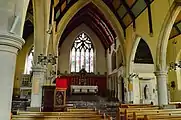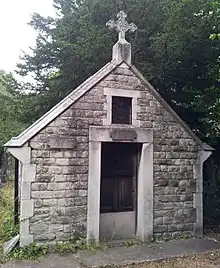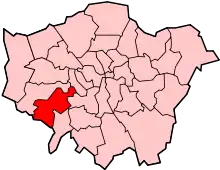St Mary Magdalen Roman Catholic Church, Mortlake
St Mary Magdalen Roman Catholic Church, Mortlake is a Roman Catholic church in North Worple Way, Mortlake, in the London Borough of Richmond upon Thames. Its priest is Canon Francis Moran.[1]
| St Mary Magdalen Roman Catholic Church, Mortlake | |
|---|---|
 | |

| |
| Location | 61 North Worple Way, Mortlake, London SW14 8PR |
| Country | England, United Kingdom |
| Denomination | Roman Catholic |
| Website | www |
| Architecture | |
| Architect(s) | Gilbert Blount |
| Style | Gothic Revival |
| Years built | 1852 |
| Administration | |
| Parish | Mortlake |
| Deanery | Mortlake |
| Diocese | Roman Catholic Archdiocese of Southwark |
| Province | Southwark |
| Clergy | |
| Priest(s) | Fr Adrian McKenna-Whyte |
The church building, in Gothic Revival style, was designed by Gilbert Blount, architect to the first Archbishop of Westminster, Nicholas Wiseman, and dates from 1852.[2][3][4]
The church's first parish priest, Fr John Wenham, was a convert from the Oxford Movement,[2] who had studied at Magdalen College, Oxford[5] and had been an Anglican army chaplain in Ceylon.[6]
Burials
- John Francis Bentley (1839–1902), the architect of Westminster Cathedral in London, is buried in the churchyard.
- Walter Blount (1807–1894), a long-serving officer of arms at the College of Arms in London, is buried in the churchyard.[7]
- Katharine Harris Bradley (1846–1914) and her niece and ward Edith Emma Cooper (1862–1913), who together wrote about 40 works of poetry and verse drama and long journal Works and Days, using the pseudonym Michael Field, were buried together in the churchyard. A now-lost marble tomb was erected in 1926.
- Alexander Kerr (1838-1909) a Scottish banker who was the first manager for the Bank of New Zealand.
- Donald MacGregor (1839–1911) was a Scottish Liberal Party politician. From 1892 to 1895 he was a Member of Parliament for the Inverness-shire constituency. He is buried in the churchyard.[7]
- May Probyn (1856–1909), British fin de siècle poet, is buried in the churchyard. She published a novel in 1878, and became a Catholic convert in the following decade.[7][8]
- Leonard Stokes (1858–1925), an architect who designed many Roman Catholic buildings, including churches, convents and schools, as well as country houses and around 20 telephone exchanges, is buried in the churchyard. In 1919 he was awarded the Gold Medal of the Royal Institute of British Architects, having served as its president from 1910 to 1912.[9]
Sir Richard and Lady Burton
The cemetery includes a Grade II* listed[10] tent-shaped mausoleum of Carrara marble and Forest of Dean stone,[10] containing the tombs of the Victorian explorer Sir Richard Burton (1821–1890) and his wife, Isabel, Lady Burton (née Arundell; 1831–1896), who designed it;[3] she also erected the memorial stained-glass window to Burton, which is next to the lady chapel in the church.[11]
Comte de Vezlo Mausoleum
The cemetery includes another mausoleum, commemorating the very young Comte de Vezlo, Guilaume Henri (1894–1901). A plaque near the mauseolum's entrance also commemorates his mother, Annette Rosamonde Blasio, the Comtesse de Vezlo, who died in 1938.[12] The architect is not known.[13]
Sir James Marshall
Sir James Marshall (1829–1889), a British colonial judge who helped the spread of Roman Catholicism in Ghana and Nigeria, is buried in the churchyard cemetery.[2][14] His wife Alice (née Young) died in 1926 and is also buried in the churchyard. A memorial plaque inside the church was unveiled on 11 August 1999, 100 years after his death.[15]
The Knights and Ladies of Marshall, a lay association of Ghanaian Catholics, visit the church in Mortlake annually to celebrate a Mass in his memory.[2][15]
War graves
The cemetery contains war graves of four service personnel of World War I and two of World War II.[16][17][18]
| Wikimedia Commons has media related to St Mary Magdalen, Mortlake. |
 Interior
Interior Mausoleum of Sir Richard and Lady Burton
Mausoleum of Sir Richard and Lady Burton Comte de Vezlo Mausoleum
Comte de Vezlo Mausoleum%253BSt_Mary_Magdalen%252CMortlake.jpg.webp) Grave of Sir James Marshall and his wife Alice
Grave of Sir James Marshall and his wife Alice_and_Alice%253BSt_Mary_Magdalen%252CMortlake.jpg.webp) Grave of Sir James and Lady Alice Marshall: inscription
Grave of Sir James and Lady Alice Marshall: inscription
See also
References
- "Welcome to St Mary Magdalen Church Mortlake". St Mary Magdalen Roman Catholic Church Mortlake. Retrieved 17 February 2016.
- "The Parish of St. Mary Magdalen, Mortlake: A brief history". About the Church. St Mary Magdalen Roman Catholic Church Mortlake. Retrieved 26 September 2017.
- Bridget Cherry and Nikolaus Pevsner (1983). The Buildings of England – London 2: South. London: Penguin Books. p. 513. ISBN 0-14-0710-47-7.
- "Mortlake – St Mary Magdalen". Taking Stock. Catholic Churches of England & Wales.
- "St Mary Magdalen Roman Catholic Church and Cemetery". Barnes and Mortlake History Society. Retrieved 27 February 2013.
- Gorman, W Gordon (1910). Written at Covent Garden. Converts to Rome: a biographical list of the more notable converts to the Catholic Church in the United Kingdom during the last sixty years. London: Sands & Co.
- Meller, Hugh: Parsons, Brian (2011). London Cemeteries: An Illustrated Guide and Gazetteer (Fifth ed.). Stroud, Gloucestershire: The History Press. p. 261. ISBN 978 0 7524 6183 0.
- "Probyn, May". The Androom Archives. 10 September 2019.
- "St Mary Magdalen's Roman Catholic Churchyard". London Gardens Online. London Parks and Gardens Trust. Retrieved 10 September 2019.
- Historic England (30 October 1973). "Mausoleum of Sir Richard and Lady Burton, Churchyard of St Mary Magdalen (1065392)". National Heritage List for England. Retrieved 24 July 2020.
- "The Tomb of Sir Richard Burton". St Mary Magdalen Roman Catholic Church Mortlake. Retrieved 5 July 2020.
- "Comte de Vezlo Mausoleum". Heritage of London Trust. Retrieved 29 September 2017.
- "De Vezlo Mausoleum". Mausolea and Monuments Trust. Retrieved 29 September 2017.
- "Sir James Marshall". Knights and Ladies of Marshall. Retrieved 17 February 2016.
- "About the Church: Other Features". St Mary Magdalen Roman Catholic Church Mortlake. Retrieved 24 February 2015.
- "War Graves in our Cemetery". St Mary Magdalen Roman Catholic Church Mortlake. Retrieved 5 January 2020.
- "Mortlake (St. Mary Magdalen) Roman Catholic Churchyard". Cemetery details. Commonwealth War Graves Commission. Retrieved 5 July 2020.
- "Mortlake (St. Mary Magdalen) Roman Catholic Churchyard". Casualty war records. Commonwealth War Graves Commission. Retrieved 5 July 2020.
